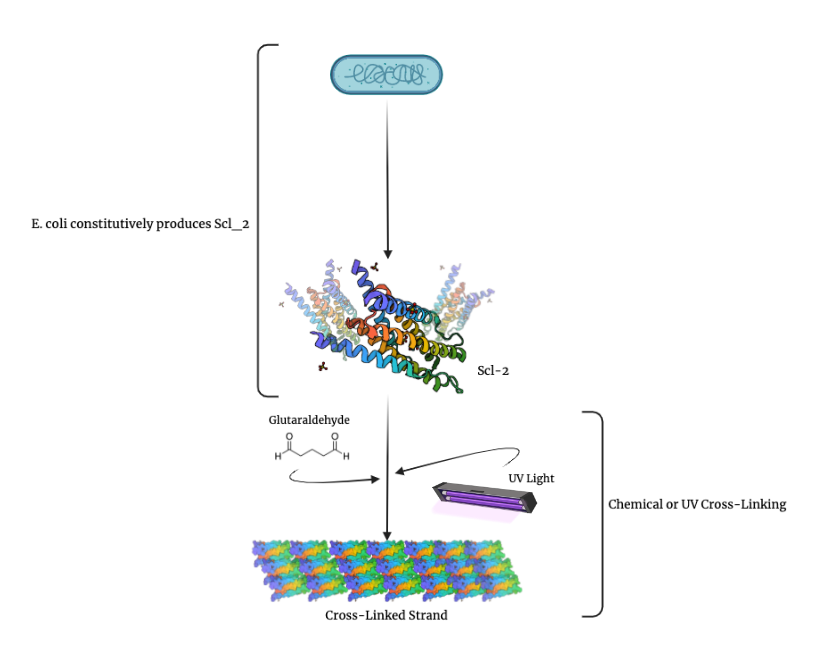Part:BBa_K3833000
Streptococcal Collagen-Like Protein
Streptococcal Collagen-Like Protein (Scl2) was originally discovered in gram-positive S. pyogenes. It is a prokaryotic protein that can be used to mimic human collagen and has been shown to form stable triple helices[1].
Scl2 is easily expressed in E. coli and lacks the requirement for post-translational modifications; this makes it a useful alternative to recombinant human collagen expressed in eukaryotic organisms[1]. For these reasons, we chose Scl2 as the backbone for Collatrix — a collagen-mimetic gradient hydrogel for bone-soft tissue interfaces.
Scl2 can be modified to specific locations with common mammalian cell binding sites, such as fibronectin and integrin [3]. After is it produced, it can be cross-linked both chemically (with the use of glutaraldehyde) and with UV light in order to create hydrogels to serve as scaffolds for cell growth.
The sequence for this part originated from the S. pyogenes native protein sequence [4], and was codon-optimized [2] for expression in E. coli. Modeling The modeling for the production of Scl2 was based on the following equation:
Where sigma is the basal production rate of Scl2 based on our constitutive promoter, x is the number of E. coli, R is the degradation rate of Scl2, and P is the concentration of Scl2 in μm/mL.
We modeled this production using differing Scl2 half-lives. We used three different half-lives based on degradation rates found during the literature review. Figure 2 plots an average half-life, while figures 3 and 4 plot maximal and minimal protein degradation respectively. While we expect the plot in figure 2 to be most realistic, we modeled three different situations to make sure that the Scl2 would be at a sufficient concentration to cross-link in both minimal and maximal degradation conditions [1].
Table 1. Parameter Values for Scl2 Modeling
| Variable | Parameter | Value | Source |
|---|---|---|---|
| Sigma | Basal Expression | 1.53 *10^-16 uM/s/cell | [6] |
| R | Degredation Rate of Scl2 | 4.18 * 10^-6 h^-1 | [7] |
| x | Number of E.Coli | 1.98 * 10^14 | [8] |
| P | Concentration of Scl2 (μm/mL) | -- | -- |
References:
[1] An, B., Kaplan, D. L., & Brodsky, B. (2014). Engineered recombinant bacterial collagen as an alternative collagen-based biomaterial for tissue engineering. Frontiers in Chemistry, 2, 40. https://doi.org/10.3389/fchem.2014.00040
[2] Codon Optimization. (n.d.). VectorBuilder. Retrieved from https://en.vectorbuilder.com/tool/codon-optimization.html.
[3] Parenteau-Bareil, R., Gauvin, R., & Berthod, F. (2010). Collagen-Based Biomaterials for Tissue Engineering Applications. Materials, 3(3), 1863–1887. https://doi.org/10.3390/ma3031863
[4] UniProtKB - Q8RLX7. (n.d). UniProt. Retrieved from https://www.uniprot.org/uniprot/Q8RLX7.
[5] Bionumers. Typical Protein Half-Life. Retrieved from https://bionumbers.hms.harvard.edu/bionumber.aspx?s=n&v=2&id=111930
[6] Maurizi, M.R (1992). Proteases and Protein Degradation in Escherichia coli. Laboratory of Cell Biology, National Cancer Institute, Bethesda, 48. Retrieved from https://link.springer.com/content/pdf/10.1007/BF01923511.pdf.
[7] Peng, Yong Y., Yoshizumi, Ayumi, Danon, Stephen J., Glattauer, Veronica, Prokopenko, Veronica, Mirochnitchenko, Oleg, Yu, Zhuoxin, Inouye, Masayori, Werkmeister Jerome A.,Brodsky, Barbara, Ramshawa, John A.M. A Streptococcus pyogenes derived collagen-like protein as a non-cytotoxic and non-immunogenic cross-linkable biomaterial. Biomaterials 31(10), 2009. https://doi.org/10.1016/j.biomaterials.2009.12.040.
[8] Pletnev P, Osterman I, Sergiev P, Bogdanov A, Dontsova O. Survival guide: Escherichia coli in the stationary phase. Acta Naturae. 2015;7(4):22-33.
Sequence and Features
- 10INCOMPATIBLE WITH RFC[10]Illegal PstI site found at 397
Illegal PstI site found at 406
Illegal PstI site found at 415
Illegal PstI site found at 469 - 12INCOMPATIBLE WITH RFC[12]Illegal PstI site found at 397
Illegal PstI site found at 406
Illegal PstI site found at 415
Illegal PstI site found at 469 - 21INCOMPATIBLE WITH RFC[21]Illegal BglII site found at 207
- 23INCOMPATIBLE WITH RFC[23]Illegal PstI site found at 397
Illegal PstI site found at 406
Illegal PstI site found at 415
Illegal PstI site found at 469 - 25INCOMPATIBLE WITH RFC[25]Illegal PstI site found at 397
Illegal PstI site found at 406
Illegal PstI site found at 415
Illegal PstI site found at 469
Illegal NgoMIV site found at 517
Illegal NgoMIV site found at 751
Illegal NgoMIV site found at 1230
Illegal AgeI site found at 1237 - 1000COMPATIBLE WITH RFC[1000]
| None |





